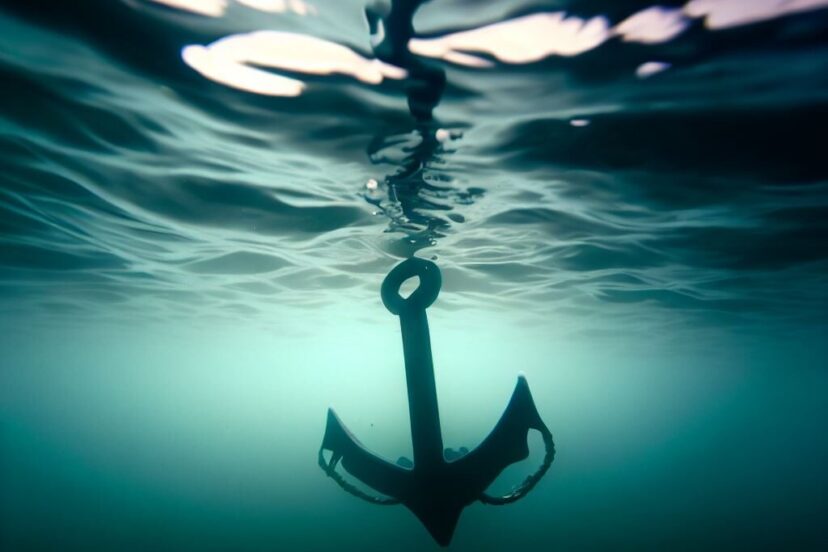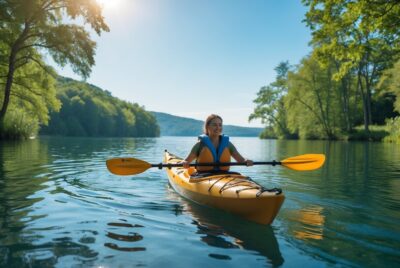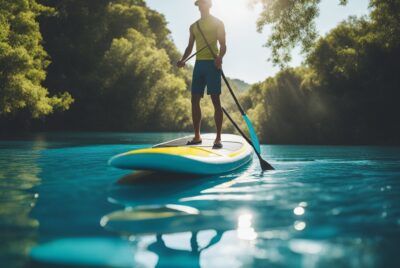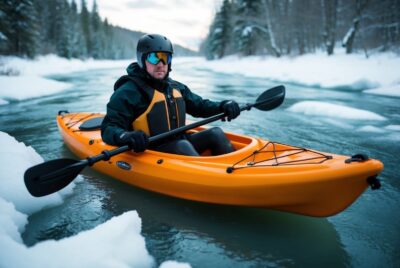Kayak Anchor: An Essential Tool
*We may earn a commission for purchases made using our links. Please see our disclosure to learn more.
Kayak Anchor: Essential Tips for Secure and Safe Paddling
Kayak anchors are essential tools for anyone who enjoys spending hours on the water. These anchors keep your kayak from drifting away, providing stability and security in various water conditions. Whether you’re fishing, taking photographs, or simply relaxing, a kayak anchor can be a game changer.
When choosing a kayak anchor, several factors must be considered. The weight and type of the anchor are crucial. You need an anchor heavy enough to keep your kayak in place but not so heavy that it becomes cumbersome. The material of the anchor also matters, as it affects durability and performance. Additionally, the length and strength of the rope connected to the anchor are important for ensuring it can hold firm in different types of waterbeds.
I spent countless hours researching various kayak anchors to identify the best options that provide reliable performance and ease of use.
Best Kayak Anchors
I’ve reviewed the top kayak anchors for stability and ease of use. Check out my selection of the best options available.
Best Marine Kayak Anchor
This is a fantastic choice for anyone who wants a reliable anchor for their kayak or small watercraft.
Pros
- Upgraded components for better performance
- Works well in both saltwater and freshwater
- Includes a long, 40-foot rope
Cons
- The rope may start to fray after some use
- Not the best for very rough waters
- Maybe too light for some larger watercraft
I’ve used the Best Marine Kayak Anchor and found it to be very effective. The upgraded components really make a difference. I felt confident using it in both saltwater and freshwater environments due to its carbon steel material. The 40-foot rope gave me a lot of flexibility, and the carabiner made it simple to attach.
One thing I noticed is that the rope began to fray after several uses. It’s still usable, but it’s something to keep an eye on. Also, while it holds well in moderate conditions, it might struggle a bit in very rough waters. Lastly, at 3.5 pounds, this anchor might be too light for larger boats.
Overall, I think this is a solid anchor for kayaks and small boats. It has some minor drawbacks, but the pros definitely outweigh the cons for me. The anchor’s easy-to-use design and reliable holding power make it a worthy addition to my kayaking gear.
Gradient Fitness Kayak Anchor
This kayak anchor is a reliable choice for anyone looking for convenience and durability in one package.
Pros
- Compact and easy to store
- Rust-resistant material
- User-friendly deployment
Cons
- May not hold well in strong currents
- Rope length might not be sufficient for deeper waters
- Bag could use more padding
I found the Gradient Fitness Kayak Anchor to be very practical. Its compact size and foldable design make it easy to store and transport. I could quickly set it up and pack it away without any hassle.
The anchor is made of rust-resistant materials, which adds to its durability. I used it in both saltwater and freshwater, and it held up well without any signs of corrosion.
Deploying and retrieving the anchor is straightforward. The anchor comes with a buoy and a snap hook, making it even easier to use. It’s great for someone who doesn’t want to spend a lot of time fumbling with their gear.
In moderate conditions, it had no trouble keeping my kayak in place. The only issue I faced was in stronger currents, where it struggled a bit. This shouldn’t be a problem for calmer waters.
For anyone looking for a compact and reliable kayak anchor, the Gradient Fitness Kayak Anchor is a solid choice.
Newport Mushroom Anchor Kit
This anchor kit is a solid choice for those looking to steady their small watercraft with ease.
Pros
- Durable PE coated cast iron
- Comes with all necessary accessories
- Easy to store and carry
Cons
- Might not hold well in strong currents
- The included rope could be longer
- Heavier than some might prefer
This Newport Mushroom Anchor Kit is a reliable piece of equipment for anyone who kayaks on lakes or calm waters. I found the cast iron durability and PE coating to both be up to the task. The coating prevents rust and wear, making the anchor last longer.
Carrying the anchor around is convenient thanks to its small size and the included carrying bag. This is especially useful if you have limited space in your kayak. Other items like the buoy and rope make it easy to spot and retrieve your anchor, especially in murky water.
Though it works well in calm conditions, the anchor’s 5lb weight may not hold your kayak in place if there’s a strong current. Also, the 30-foot rope might not be sufficient for deeper waters. Despite these drawbacks, it’s a well-constructed and handy tool for most kayak outings.
Lounsweer Kayak Anchor Kit
This kayak anchor kit is a reliable choice for a stable and enjoyable water experience.
Pros
- High visibility marker buoy makes it easy to locate
- Foldable design for easy storage
- Rust-resistant materials for durability
Cons
- Occasionally, one claw might not extend properly
- Not suitable for larger watercrafts like jet skis
- Needs a bit of fine-tuning out of the box
I recently tested the Lounsweer Kayak Anchor Kit, and it impressed me with its functionality and ease of use. The fact that it folds down to a compact size was a big plus, making it very easy to stow away. When in use, the bright color ensured that I never lost track of where the anchor was positioned, which added peace of mind.
On the downside, one of the claws needed a bit of filing to work perfectly, but it wasn’t a big issue. It’s also worth noting that this anchor isn’t built for larger watercraft. It’s designed for smaller kayaks or paddle boards, so don’t expect it to hold a jet ski in place.
Overall, the durability of this anchor stands out. Made from rust-resistant galvanized iron, it holds up well in both fresh and saltwater. This makes it a dependable choice for regular use. If you’re an outdoor lover looking for a handy kayak anchor, this kit could be just what you need.
XGeek Kayak Anchor
This XGeek Kayak Anchor is a reliable and easy-to-use option for anyone venturing onto the water with a kayak, SUP, or small boat.
Pros
- Durable and resistant to corrosion
- Lightweight and easy to carry
- Secure and stable when deployed
Cons
- Rope can tangle if not stored carefully
- Not ideal for very strong currents
- Limited color options
I recently took the XGeek Kayak Anchor out for a test in the lake. It was a breeze to carry around thanks to its lightweight design. At just 3.5 pounds, it didn’t add much extra weight to my gear.
What really impressed me was how secure the anchor was once I deployed it. Even in a mild current, my kayak stayed in place. The galvanized carbon steel is built to last and resisted any signs of rust, even after a day in saltwater.
On the downside, the rope can get tangled if you’re not careful. Storing it properly is key to avoiding this issue. Despite this minor drawback, the anchor’s overall performance makes it a solid choice for kayakers and other water enthusiasts alike.
Ojomow Anchor Kit
This anchor kit is perfect for anyone who wants to keep their kayak or jet ski stable.
Pros
- Easy to install and remove
- Stays flat on the riverbed
- Organized 50ft strong rope
Cons
- No instructions included
- May be overkill for smaller kayaks
- Slightly heavy for some
I used the Ojomow Anchor Kit last weekend, and it was really simple to set up. The stainless steel chain helped keep the anchor flat on the riverbed, which was great because my kayak didn’t drift much at all.
This kit includes a 50ft rope that’s neatly organized, making it easy to store and use again. One thing I liked was the anchor cleat that holds the rope securely; it felt very effective when I was out fishing in my kayak.
On the downside, the lack of instructions was frustrating initially. It might take some trial and error to figure out. Other than that, it functions well and feels sturdy, making it a reliable choice for serious kayakers.
Arya Life Kayak Anchor
Looking for a reliable anchor for your kayak? This one is a great pick.
Pros
- Compact and easy to store
- Durable, rust-resistant material
- Includes a padded storage bag
Cons
- Rope may be too thin for some users
- Flotation buoy might get in the way
- May not hold well in very rocky areas
I tried out the Arya Life Kayak Anchor on my last kayaking trip. The anchor’s compact size made it easy to carry and store. The anchor dug into the sandy floor of the lake effortlessly, keeping my kayak securely in place.
One thing I loved about this anchor is the rust-resistant finish. Even after several hours in the water, it showed no signs of corrosion. The anchor’s rope is long enough for most situations, giving me plenty of room to anchor in deeper water.
On the downside, the flotation buoy was a bit cumbersome, occasionally getting in my way. Additionally, the rope felt a bit thin, which made me worried about its durability in rougher conditions. Despite that, the anchor performed well on various bottoms, making it a strong choice for kayakers.
Buying Guide
When choosing a kayak anchor, I look at several key features to make sure it meets my needs.
Anchor Weight
The weight of the anchor is important. I need to balance between enough weight to hold my kayak steady and not too heavy to carry. Usually, 1.5 to 3 pounds works well for most kayaks.
Material
I check the material of the anchor. Stainless steel or galvanized iron are good choices. They resist rust and last longer, especially in saltwater conditions.
Anchor Type
Different types of anchors work best in different environments. Here’s a quick guide:
| Anchor Type | Best For |
| Mushroom | Soft, muddy bottoms |
| Grapnel | Rocky or weedy bottoms |
| Bruce | Sandy or mixed bottoms |
| Claw | Versatile, works in most conditions |
Rope Length
I make sure the rope is long enough. Usually, it should be 5 to 7 times the depth of the water. For example, if I plan to anchor in 10 feet of water, I need at least 50 to 70 feet of rope.
Storage
I look at how easy it is to store the anchor. Foldable or compact anchors are great as they take up less space in my kayak.
Additional Features
Some anchors come with extra features like a storage bag or a retrieving ring. These can make the anchor easier to handle and transport.
Frequently Asked Questions
There are many aspects to consider when choosing and using a kayak anchor. I will help you understand the best types of anchors, the right weight, anchor trolleys, mounting practices, key features, and DIY solutions.
1. What are the recommended types of anchors for kayaks?
The most common types are folding grapnel anchors and mushroom anchors. Folding grapnel anchors are great for rocky or rough bottoms. Mushroom anchors are best suited for soft or muddy bottoms.
2. How do I determine the appropriate weight for a kayak anchor?
The weight you need depends on the depth and type of water. For most kayaks, a 1.5 to 3.5-pound anchor is sufficient. In deeper or rougher waters, you might need a heavier anchor.
3. Can you explain the purpose and use of a kayak anchor trolley system?
An anchor trolley system allows you to move the anchor point along the side of your kayak. This helps you control the direction of your kayak. It’s especially useful in wind or currents.
4. What are the best mounting practices for a kayak anchor system?
You should mount the anchor line to a strong point on your kayak. Use cleats to secure the rope and prevent it from slipping. Avoid tying the anchor line to adjustable parts like seats or hatches.
5. Which features should I look for when choosing a kayak anchor?
Look for strong, corrosion-resistant materials, preferably stainless steel. An anchor with foldable or collapsible arms is easier to store. Consider the holding power of the anchor, which depends on weight and design.











